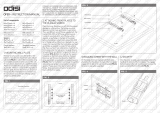Quickstart Guide
TCS series
TCS Quickstart Guide - Page - 6
Vertical Arrays with Bass Cabinets
Bass cabinets can be integrated into larger arrays using the same type of flying kits as shown on the array of TCS-B15B and TCS-
152 cabinets illustrated here.
07G0340 FP-1 kit of two (2) FP-1 flyplates for TCS-122 or TCS-152 mid/high cabinets, includes 4 x M10 x 40mm bolts and 4
x M10 spring washers
Downfill Applications
The TCS-61 can be tight-packed underneath a TCS-152 cabinet to provide downfill coverage using the SB-61 swivel bracket.
First disassemble the swivel bracket into its component parts. Remove the countersunk bolts from the bottom panel of the TCS-
152 cabinet and fit the section with the elongated holes using the fixings supplied. Remove the countersunk bolts on the top panel
and fit the swivel bracket using the supplied fixings. Re-assemble the swivel bracket, angle as appropriate and tighten all fixings.
For downfill applications under TCS-122 cabinets use two ICC-61 inter-cabinet couplers. Remove the four countersunk screws
located on the sides of the TCS-61
To use the SB-61 to install the TCS-61 in a ceiling-mount application, separate the component parts as above, and fix the top
section to the ceiling with appropriate fixings (not supplied). Fit the other half to the TCS-61 cabinet, re-assemble the bracket,
angle as appropriate and tighten all fixings.
Horizontal Arrays / Centre Clusters
As with vertical arrays, clusters are assembled using kits of flyplates and couplers.
07G0335 FP-1 KIT kit of two (2) FP-1 flyplates (one top, one bottom) for each TCS-122 or TCS-152 mid/high
includes 4 x M10 x 40mm bolts and 4 x M10 spring washer
07G0345 ICC-2H kit of two (2) 122-122 links between each TCS-122 or TCS-152 mid/high
includes 4 x M10 x 40mm bolts and 4 x M10 spring washer
07B393 EB-10/18 three (3) M10 x 18mm shoulder eyebolts
• Remove the countersunk screws from the rigging points on the
bottom of the cabinets. Fit the FP-1 flyplates and 122-122 links
using the fixings provided and tighten all fixings.
• Invert the cluster and fit the corresponding FP-1 flyplates and
122-122 links to the top of the cabinets, replacing two of the M10
screws with M10 x 18mm shoulder eyebolts fitted to the inner
rigging points on the two outside cabinets.
• Lift the cluster using the eyebolts and tilt back using the third
M10 eyebolt attached to the lower rigging point on the back of
the centre cabinet.
IMPORTANT NOTE: The rigging of a flown sound system may be dangerous unless undertaken by qualified personnel with the
required experience and certification to perform the necessary tasks. Fixing of hanging points in a roof should always be carried
out by a professional rigger and in accordance with the local rules of the venue. Walls, floors or ceilings must be capable of safely
and securely supporting the actual load. The rigging accessory used must be safely and securely fixed both to the loudspeaker
and to the wall, floor or ceiling.
When mounting rigging components on walls, floors or ceilings, ensure that all fixings and fasteners used are of an appropriate
size and load rating. Wall and ceiling claddings, and the construction and composition of walls and ceilings, all need to be taken
into account when determining whether a particular fixing arrangement can be safely employed for a particular load. Cavity plugs
or other specialist fixings, if required, must be of an appropriate type, and must be fitted and used in accordance with the maker’s
instructions.











